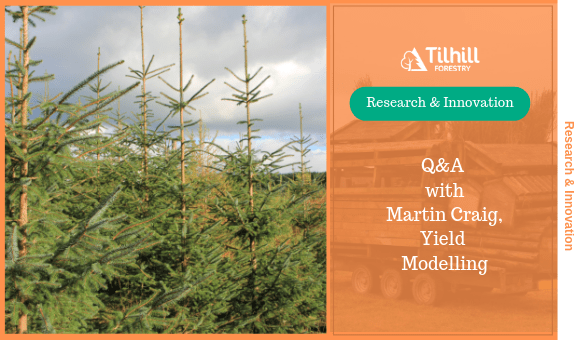Research & Innovation: Yield Modelling, Q & A with Martin Craig, Project Manager, Central Borders
What is Yield Modelling?
Yield growth models are one of the foundations of forest management providing essential information about the patterns of tree growth and thus potential productivity of trees under differing site conditions and management regimes. Yield tables, amongst other outputs, predict the potential volume, tree diameter at breast height, top height and timber breakout at different growth rates. The outputs support many other calculations and form the basis of much of the analysis required for investing in forestry. Managers in the field use these tables to assess the growth potential of the crops by measuring crop growth (forest mensuration) and assessing these against the growth models.
What does it entail?
Within the UK, forest managers have traditionally used Forest Yield Models based on data collected since the 1920’s by the Forestry Commission. These cover all our major forest species with data collected from a network of both temporary and permanent sample plots and include work on thinning and spacing experiments. They are designed primarily for even-aged silvicultural systems so have a more limited application in forests with more complex structures. Setting up these sample plots is both time consuming and expensive and requires periodic measurements to provide statistically valid data on which to base the model derivations.
Tell us about the history and why has Tilhill Forestry taken an interest in getting yield models updated.
Most of our commercial upland forests (State and Private) have been stocked with Sitka spruce of QCI origin (Queen Charlotte Islands) but Improved Sitka spruce planting stock has been available to forest managers since the early 90’s. Indeed, for the past 15-20 years, improved Sitka spruce has made up the vast majority of both our restock and new planting sites.
Stock can be obtained that range from progeny-tested clonal seed orchard material to Full sibling rooted cuttings from controlled pollination between progeny tested parents. This has given managers a much wider choice of planting and restocking material based on variations in growth rates, timber density and stem straightness. For example, predicted gains in growth rates in Sitka spruce range from 21% -29%. Recent studies from a series of 85 sample plots in Tilhill Forestry managed properties gives considerable credence to the forecast increased growth rates. In fact, when looked at against current yield models many are well above the maximum. In addition many of these crops are now reaching the age where thinning is being considered, particularly given that the roading infrastructure is much improved following harvesting.
One limitation of the current set of yield models is that most of the data references back to QCI data and there is currently a real dearth of data on this improved material and, as yet, no published yield models on which to base future predictions of growth with any certainty.
Tilhill Forestry has been working with the Forestry Research and the Conifer Breeding Co-operative to see how we can assist in providing and validating data from these improved crops so that yield models for Improved Sitka spruce can be built and made more widely available in as short a timescale as possible to the forest industry.
What are the implications and benefits to Tilhill Forestry from the work you are doing?
Predictability of outputs is a key criteria when planning the silvicultural management of any forest – decisions on if and when to thin and the type and intensity of thinning can significantly impact on the final crop volume production and timber breakout.
The existing Yield Models provided a level of comfort that managers could rely on to predict, with a reasonable amount of certainty, the impacts of differing forest interventions. The issues we have currently are that we are aware that the Improved Sitka spruce crops are growing very fast but, as yet, we do not fully understand the relationship between the top height and volume increment (a key criteria for yield modelling) nor do we fully understand the implications of this faster growth and generally narrower crowns on the mortality of these crops. We assume there will be limited mortality which will have a significant impact on timber breakout in the future. Actual mortality will be a determining factor in management decisions.
There is work ongoing on these issues and we are hopeful that an interim model currently being worked on by Forest Research will be available in the near future. These will allow managers to make more informed decisions particularly around thinning or other types of crop intervention.



